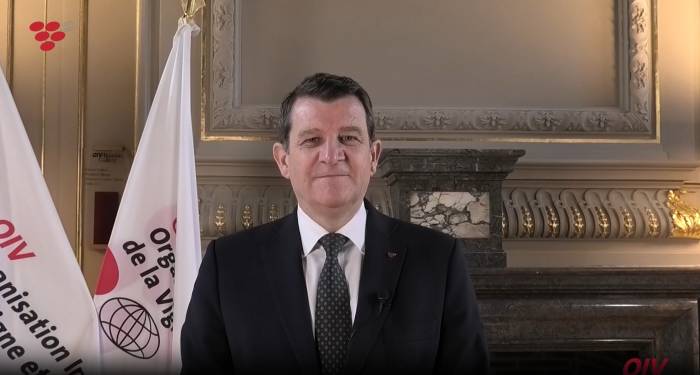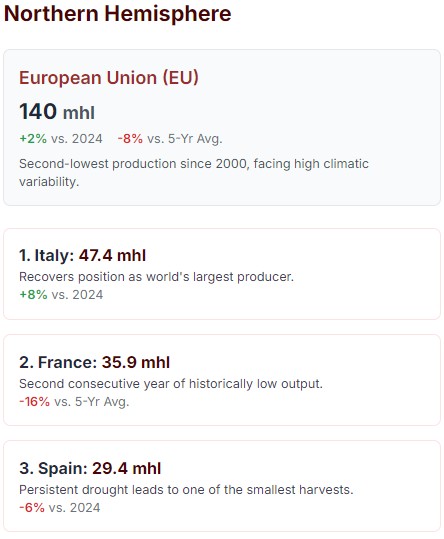Global Wine Production Reaches 232 Million Hectoliters in 2025, Up 3%
Italy leads global production, followed by France, Spain, the United States, and Australia
2025-11-12

The International Organisation of Vine and Wine (OIV) released its first estimates for global wine production in 2025 today, presenting the figures at a press conference in Dijon, France. According to the OIV, world wine production this year is expected to reach between 228 and 235 million hectoliters, with a mid-range estimate of 232 million hectoliters. This represents a 3% increase compared to the historically low harvest of 2024, but output remains about 7% below the five-year average.
John Barker, Director General of the OIV, outlined the findings and noted that while there is a modest recovery from last year’s low point, global wine production continues to face significant challenges. The OIV’s report highlights ongoing climatic variability and evolving consumption patterns as key factors shaping the current state of the industry.


Italy remains the world’s largest wine producer in 2025, with an estimated output of 47.3 million hectoliters. This places it ahead of France, which produced 35.9 million hectoliters, and Spain at 29.4 million hectoliters. The United States holds fourth place globally, while Australia has rebounded from a smaller 2024 harvest to become the fifth-largest producer this year. Argentina remains South America’s top producer.
Despite some regional differences, the OIV expects the global wine market to remain broadly balanced in 2025. Limited growth in production is likely to help stabilize inventories amid softening demand and continued uncertainty in international trade.
In Europe, total wine production is provisionally estimated at around 140 million hectoliters for 2025—a slight increase over last year but still significantly below average levels. The European Union accounts for about 60% of global output. Italy’s recovery was driven by favorable weather conditions, especially in southern regions, while France and Spain both recorded historically low harvests due to heatwaves, drought, and local storms. France’s output is now at its lowest since 1957, and Spain has seen one of its smallest harvests in decades as drought conditions persist.
Other European countries experienced mixed results. Germany saw a decline due to heavy rainfall during harvest time, while Portugal faced both drought and record rainfall earlier in the season. Some Central and Southeastern European countries—such as Romania, Hungary, and Austria—reported above-average or stable production thanks to more favorable weather.
Outside the European Union, U.S. wine production is expected to reach 21.7 million hectoliters in 2025—a partial rebound from last year but still below historical averages. California is forecast to see moderate growth, while Washington will experience a decline and Oregon a notable recovery after previous setbacks.
Russia’s wine output remains stable at around 5.1 million hectoliters, slightly above its five-year average. Georgia and Moldova also reported stable or increased volumes due to improved weather conditions compared with last year’s challenges.
In the Southern Hemisphere, total wine production is projected at about 49 million hectoliters for 2025—a moderate recovery from recent years but still below average. Australia leads with an estimated 11.6 million hectoliters after an 11% increase over last year. New Zealand expects a strong rebound with a projected harvest of 3.7 million hectoliters—its second largest on record.
Argentina’s production remains steady at around 10.7 million hectoliters, maintaining its position as South America’s leading producer. Chile faces another decline—down by 10% compared with last year—due to persistent water shortages and heatwaves that have affected yields for four consecutive years.
Brazil stands out with a significant recovery: its estimated output of about 2.9 million hectoliters marks a sharp increase from last year thanks to favorable weather throughout the growing season. South Africa also reports improved conditions and expects production close to its five-year average after two difficult vintages.
The OIV notes that these first estimates are based on preliminary data and will be updated as more information becomes available throughout the year. Final figures for global wine production in 2025 will be published in the organization’s annual report next spring.
Overall, this year’s figures reflect ongoing challenges for wine producers worldwide—from climate-related disruptions to shifting consumer demand—but also show signs of resilience in several key regions. The global market appears set for another year of limited supply growth amid continued uncertainty in trade and consumption trends.
Founded in 2007, Vinetur® is a registered trademark of VGSC S.L. with a long history in the wine industry.
VGSC, S.L. with VAT number B70255591 is a spanish company legally registered in the Commercial Register of the city of Santiago de Compostela, with registration number: Bulletin 181, Reference 356049 in Volume 13, Page 107, Section 6, Sheet 45028, Entry 2.
Email: [email protected]
Headquarters and offices located in Vilagarcia de Arousa, Spain.